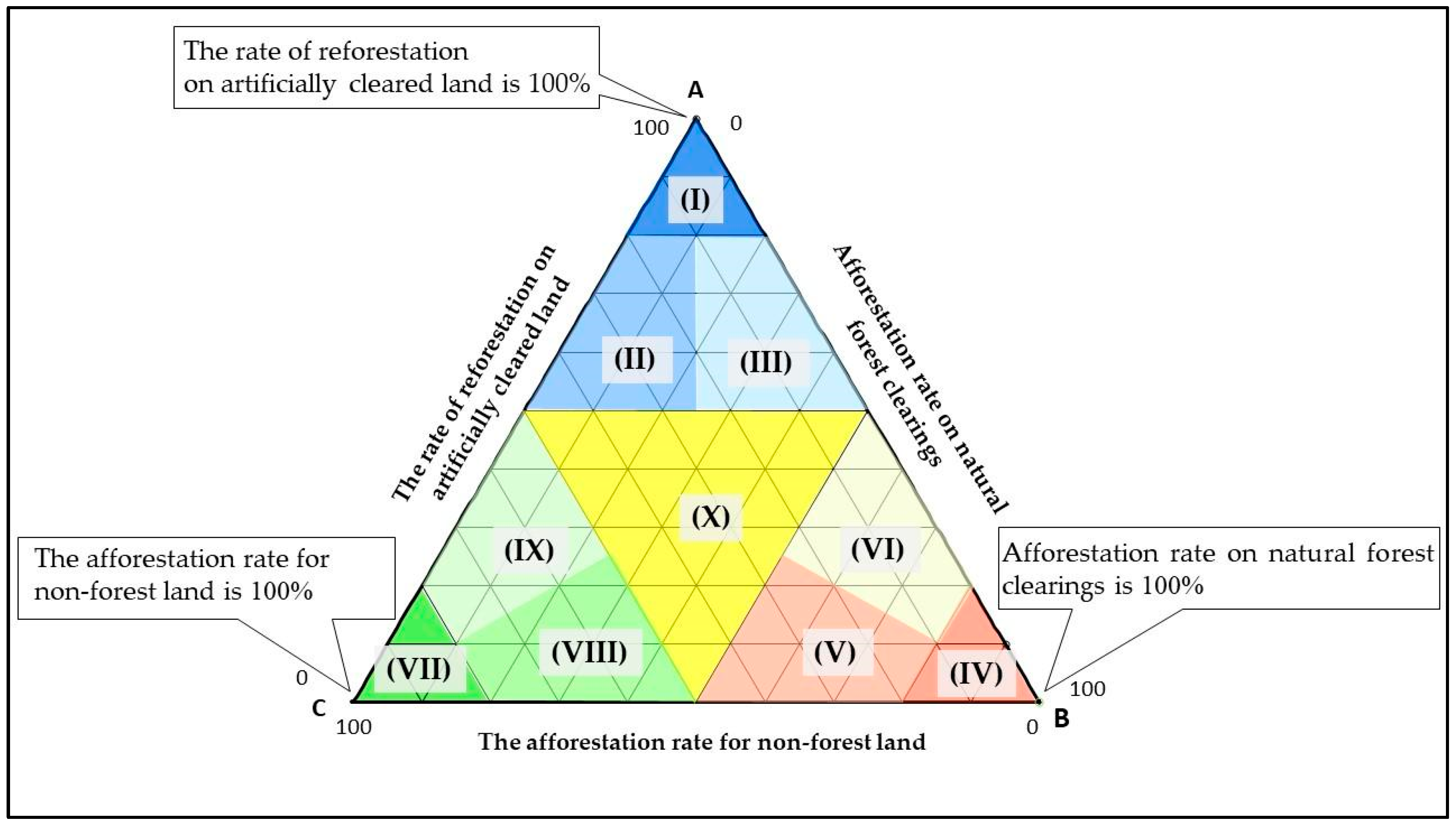Vegetation History Characteristics of Planted Forests in Japan: Analysis of the 1960 World Census of Agriculture and Forestry
Abstract
1. Introduction
2. Materials and Methods
2.1. Study Region
2.2. The 1960 World Census of Agriculture and Forestry
2.3. Study Area
2.4. Data Analysis Process
2.4.1. Digitization
2.4.2. Calculation and Graphing of Afforestation Percentages for Old Towns and Municipalities
2.4.3. Classification of Afforestation Rates
- I.
- Planted forest specialization: municipalities with a reforestation rate of more than 80 percent in areas cleared of planted forest;
- II.
- Planted forest and non-forest land: municipalities where the reforestation rate in planted forest harvesting areas is greater than 50% but less than or equal to 80%, and where the reforestation rate in areas other than mountain forests is higher than the reforestation rate in natural forest harvesting areas;
- III.
- Planted forest and natural forest: municipalities having a planted forest reforestation rate greater than 50% but less than or equal to 80%, and natural forest reforestation rates greater than that in non-forest land;
- IV.
- Natural forest specialization: municipalities with an afforestation percentage of more than 80% for clear-cut natural forest land;
- V.
- Natural forest and non-forest land: municipalities where the reforestation rate on natural forest harvesting sites is greater than 50% but less than or equal to 80%, and where the reforestation rate in areas other than non-forest land is higher than the rate on planted forest harvesting sites;
- VI.
- Natural forest and planted forest: municipalities where the reforestation rate of natural forest areas is greater than 50% but less than or equal to 80%, and where the reforestation rate of planted forest areas is higher than the rate in areas other than mountain forests;
- VII.
- Non-forest land specialization: municipalities where the afforestation percentage for non-forest land other than planted forest clear-cut land is greater than 80%;
- VIII.
- Non-forest land and natural forest: municipalities where the reforestation rate in areas other than mountain forests is greater than 50% but less than or equal to 80%, and where the reforestation rate in natural forest harvesting areas is greater than that in planted forest harvesting areas;
- IX.
- Non-forest land and planted forest: municipalities where the reforestation rate in areas other than mountain forests is greater than 50% but less than or equal to 80%, and where the reforestation rate in planted forest harvesting areas is higher than in natural forest harvesting areas;
- X.
- Mix: municipalities with afforestation rates of 50% or less for each land classification.
2.4.4. Mapping of Afforestation Percentages
2.4.5. Calculation of Grassland Area and Utilization Rates in the Three Regions
3. Results
3.1. Characteristics of the Planted Forest Vegetation History in Hokkaido
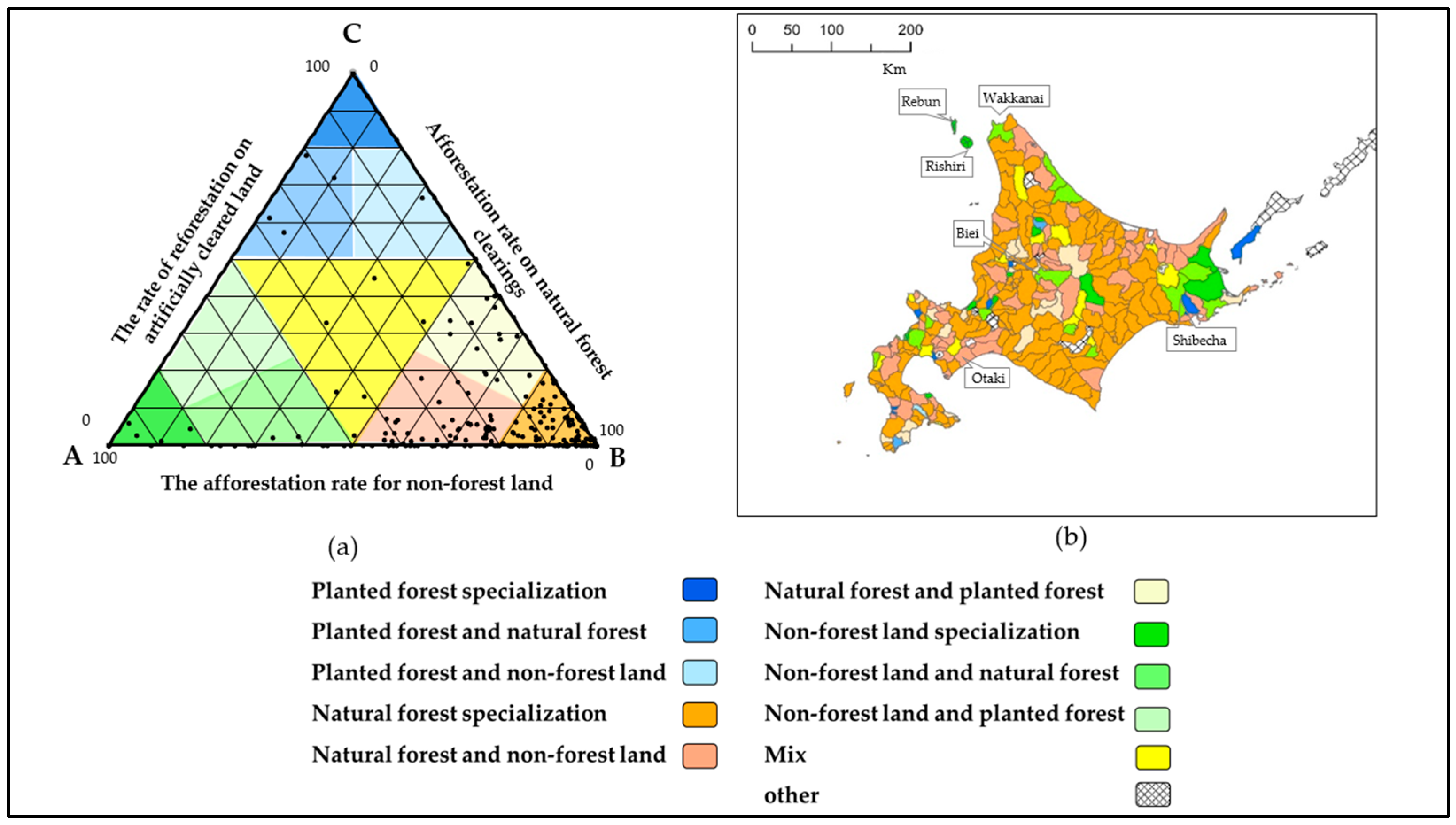
3.2. Characteristics of the Planted Forest Vegetation History in Kyushu
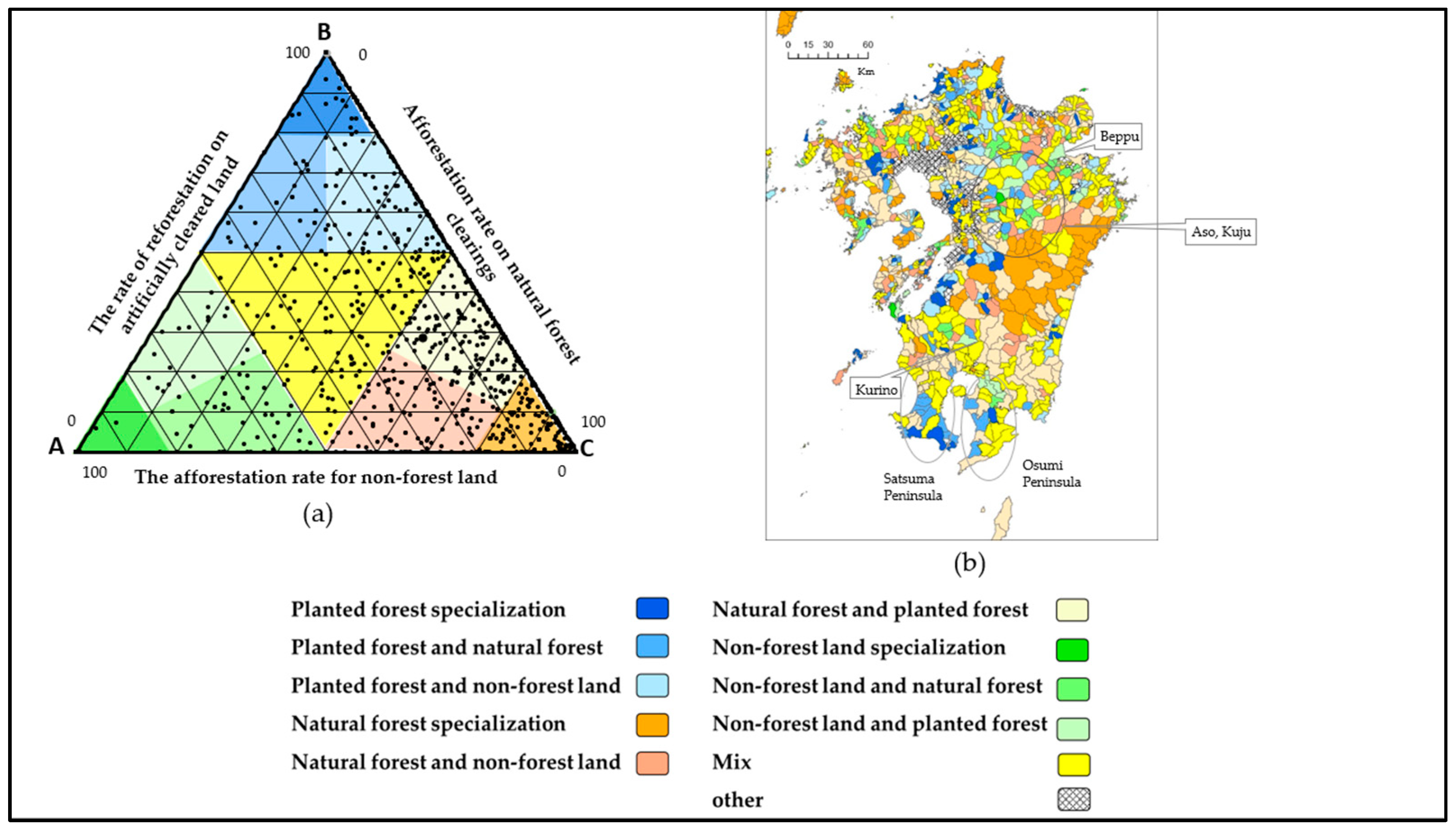
3.3. Characteristics of the Planted Forest Vegetation History in Kinki
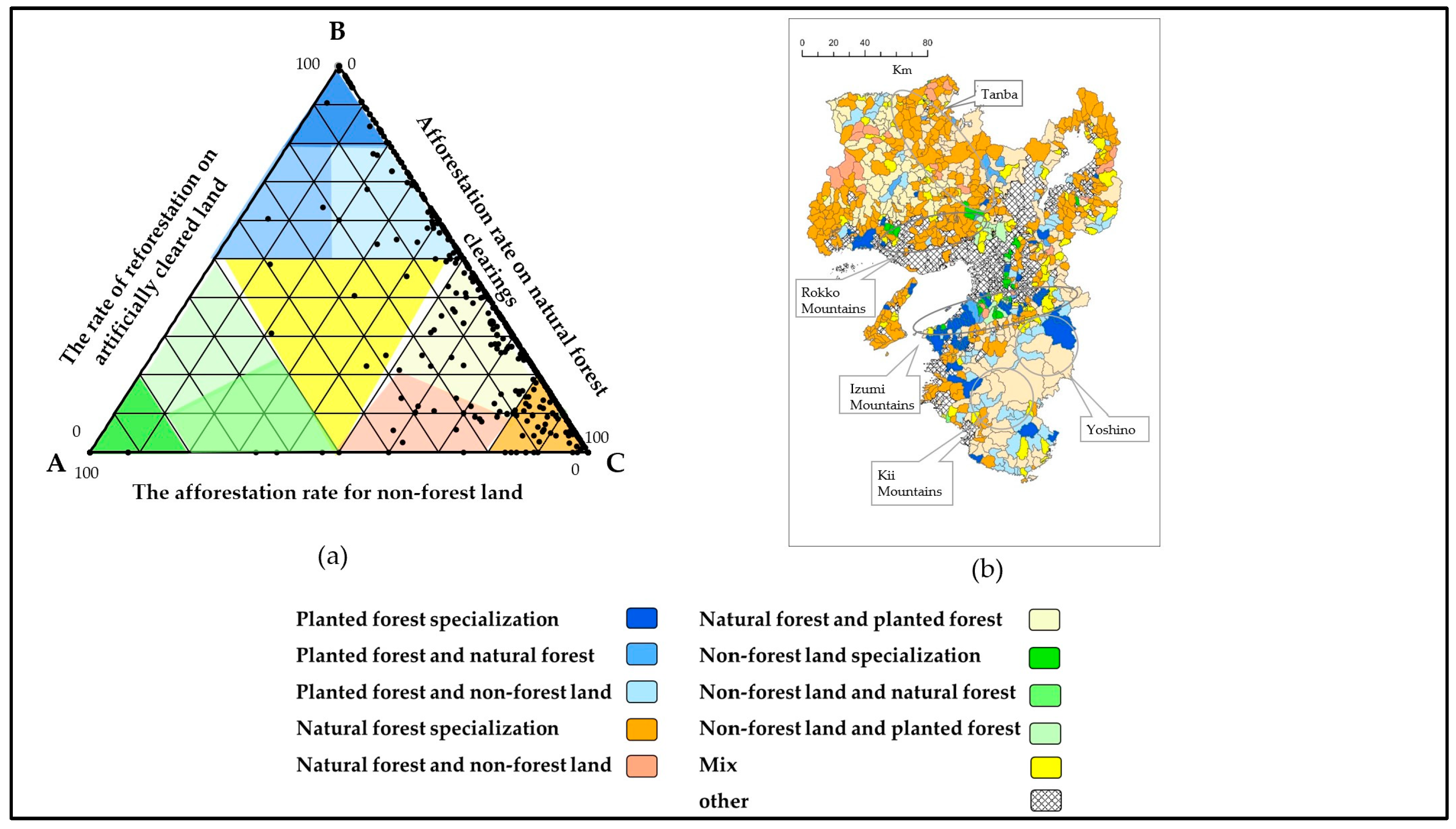
3.4. Comparison of the Percentage of Grassland in Three Regions since 1960
4. Discussion
4.1. Hokkaido
4.2. Kyushu
4.3. Kinki
5. Conclusions
Author Contributions
Funding
Data Availability Statement
Acknowledgments
Conflicts of Interest
References
- Southworth, J.; Nagendra, H.; Cassidy, L. Forest transition pathways in Asia—Studies from Nepal, India, Thailand, and Cambodia. J. Land Use. Sci. 2012, 7, 51–65. [Google Scholar] [CrossRef]
- Brookfield, H.; Byron, Y. Deforestation and timber extraction in Borneo and the Malay Peninsula. Glob. Environ. Chang. 1990, 1, 42–56. [Google Scholar] [CrossRef]
- Fujita, Y. How We Created 10 million hectares of Planted Forests? Forest Sci. 1997, 19, 9–14. (In Japanese) [Google Scholar]
- Annual Report on Forest and Forestry in Japan Fiscal Year 2022 (Summary). “Intensification and Morphological Changes of Mountain Disasters Caused by Climate Change and Forestry” and” Rural Communities in Hilly and Mountainous Areas”. Available online: https://www.rinya.maff.go.jp/j/kikaku/hakusyo/r4hakusyo/attach/pdf/index-6.pdf (accessed on 27 October 2023).
- Forestry Agency. Current Status of Forest Resources 2022. Trend of Forest Area and Accumulation. Available online: https://www.rinya.maff.go.jp/j/keikaku/genkyou/r4/attach/pdf/2-2.pdf (accessed on 27 January 2023). (In Japanese)
- Japan Meteorological Agency. Prediction Information for Global Warming; Japan Meteorological Agency: Tokyo, Japan, 2013; Volume 8. (In Japanese)
- Ito, S.; Nakayama, R.; Buckley, G.P. Effects of previous land-use on plant species diversity in semi-natural and plantation forests in a warm-temperate region in Southeastern Kyushu, Japan. Forest. Ecol. Manag. 2004, 196, 213–225. [Google Scholar] [CrossRef]
- Rebellion of the Wild. Available online: https://www.nippon.com/en/features/c03914/ (accessed on 20 November 2023).
- Takatsuki, S. Effects of sika deer on vegetation in Japan: A review. Biol. Conserv. 2009, 142, 1922–1929. [Google Scholar] [CrossRef]
- Koike, S. The relationship with betwenn with forest and, animal, human beings. In Forest and Wildfire, 2nd ed.; Koike, S., Yamaura, Y., Taki, H., Eds.; Kyoritsu Publishing: Tokyo, Japan, 2019; pp. 10–11. (In Japanese) [Google Scholar]
- Millennium Ecosystem Assessment. Ecosystem and Human Well-Being: Synthesis; Island Press: Washington, DC, USA, 2005. [Google Scholar]
- Mitsuda, Y.; Ito, S. Analysis of the effects of natural and social environment on land-use type using the National Land Numerical Information: A case study in Miyazaki Prefecture. Bull. Int. Assoc. Landsc. Ecol.-Jpn. 2003, 8, 23–31. (In Japanese) [Google Scholar]
- Soen, N.; Ito, S.; Mituda, Y. Land-use changes and their factors in mountainous forest landscapes in mountainous region of Kyushu, southern Japan. Landsc. Ecol. Manag. 2009, 14, 129–138. (In Japanese) [Google Scholar] [CrossRef]
- Shiba, E.; Nagasawa, R. Analysis on the seminatural grassland landscape changes in the Sendaigawa Watershed, Tottori Prefecture using temporal geographic information. Landsc. Ecol. Manag. 2019, 14, 153–161. (In Japanese) [Google Scholar]
- Itohl, A.; Nagasawa, R. The Land Use and Landscape Changes in the Rural Mountainous Area since Meiji Era 1890’s)—A case study in Moroga village. Landsc. Ecol. Manag. 2007, 11, 93–104. (In Japanese) [Google Scholar] [CrossRef]
- Sato, Y. Forest utilization and human cognition of the environment: Afforestation of common land in Oguni-machi. Kumamoto Prefecture. Geogr. Rev. Jpn Ser. A Chirigaku Hyoron 2001, 74, 63–82. (In Japanese) [Google Scholar] [CrossRef][Green Version]
- Yoshida, K. Changes in mountain slope landscape by expanding planted forests in Ashikita, Kumamoto Prefecture: Focusing on the working styles of residents before and after the decline in shifting cultivation. Geogr. Rev. Jpn. 2017, 5, 459–474. (In Japanese) [Google Scholar][Green Version]
- Nakajima, K. Traditional environmental use at the foot of MT. Sefuri—Through the Subjective Environmental Division. Hum. Geogr. 1986, 38, 41–55. (In Japanese) [Google Scholar] [CrossRef][Green Version]
- Sekido, A. The social-spatial organization of forest-lands and the subjective classification of its lands in a shifting cultivation village. Hum. Geogr. 1994, 46, 144–165. (In Japanese) [Google Scholar] [CrossRef][Green Version]
- Someya, T.; Kamada, M.; Nakagoshi, N.; Nehira, K. Pattern and process of vegetation landscape in a mountainous Farrn village-A case Studyat Hiwa-cho, Hiroshirna Prefecture. Geogr. Sci. 1989, 44, 53–69. (In Japanese) [Google Scholar][Green Version]
- Sakai, S.; Ichinose, T. Land use change and the factors in the hilly and mountainous area: A case of study in Kugino, Minamata city. Rep. City Plan. Inst. Jpn. 2019, 17, 393–399. (In Japanese) [Google Scholar] [CrossRef] [PubMed]
- Okano, T.; Hara, Y. Digital spatial data construction and land cover change analysis of terraced paddies using 1953 large-scale aerial photographs in the middle part of Arida River watershed. J. Rural. Plan. 2019, 38, 128–135. [Google Scholar] [CrossRef]
- Fujita, Y. Theory of the Formation of Japan’s Afforestation Regional Areas; Kokon Shoin: Tokyo, Japan, 1995; pp. 366–382. (In Japanese) [Google Scholar]
- Ellis, E.C.; Klein Goldewijk, K.; Siebert, S.; Lightman, D.; Ramankutty, N. Anthropogenic transformation of the biomes, 1700 to 2000. Glob. Ecol. Biogeogr. 2010, 19, 589–606. [Google Scholar] [CrossRef]
- Harada, I.; Matsumura, T.; Hara, K.; Kondoh, A. Spatial analysis of changes in Japanese forests during the process of modernization. Landsc. Ecol. Manag. 2011, 16, 17–32. (In Japanese) [Google Scholar] [CrossRef]
- Mitsuda, Y.; Ito, S. Comparison of the effect of natural and social environment on land-use selection between artificial and natural-forest. Landsc. Ecol. Manag. 2004, 9, 63–70. (In Japanese) [Google Scholar] [CrossRef]
- Ueno, R.; Fujiwara, T.; Sato, N.; Fujioka, Y. Where did people plant trees during the expansion of afforestation? An analysis of Kyushu using the 1960 world agricultural and forestry census. Kyushu For. Res. 2022, 75, 97–100. (In Japanese) [Google Scholar]
- Forestry Agency. Forest and Forestry Statistics Overview. In Part IV; Forest Products Communications. 2022. Available online: https://www.rinya.maff.go.jp/j/kikaku/toukei/attach/pdf/youran_mokuzi2022-12.pdf (accessed on 27 January 2023). (In Japanese)
- Seiwa, K. Changes in Forests and Trees in Changes in Forests in Relation to Human, 2nd ed.; Nakashizuka, T., Kikusawa, K., Eds.; Kyoritsu Publishing: Tokyo, Japan, 2018; p. 145. [Google Scholar]
- Forestry Agency. Forest and Forestry Statistics Overview. National Economy and Forest Resources. Part I. 2022. Available online: https://www.rinya.maff.go.jp/j/kikaku/toukei/attach/pdf/youran_mokuzi2022-11.pdf (accessed on 27 January 2023). (In Japanese)
- Ministry of Land, Infrastructure, Transport and Tourism. National Land Numerical Information Download Administrative District 3.0 Edition. Available online: https://nlftp.mlit.go.jp/ksj/gml/datalist/KsjTmplt-N03-v3_0.html (accessed on 7 November 2021).
- Twara, H. Landscape of Hokkaido: Historical review of environmental change and conservation. J. Jpn. Inst. Landsc. Archit. 1994, 58, 22–27. (In Japanese) [Google Scholar] [CrossRef]
- Postwar History of Forestry in Hokkaido Editing Committee Meeting. Postwar History of Forestry in Hokkaido; Hokkaido Ringyoukaikan: Hokkaido, Japan, 1983; Volume 249, pp. 257, 817–820, 833, 863–865. (In Japanese) [Google Scholar]
- Forestry Agency. Overview of the Rebun Forest office. Introduction to Rebun Island. Available online: https://www.rinya.maff.go.jp/hokkaido/soya/kannnaigaiyou/pdf/h24rebun.pdf (accessed on 15 November 2022).
- Wakkanai City. Trends in Agriculture and Forestry in Wakkanai City—Section 6: Overview of Forestry. Available online: https://www.city.wakkanai.hokkaido.jp/files/00010300/00010363/20160803170417.pdf (accessed on 3 January 2022). (In Japanese).
- Obihiro District Forestry Office; National Forestry Extension Association in Japan. A Prayer and Outlook for 100 Years of Forestry in Eastern Hokkaido; Obihiro District Forestry Office: Obihiro, Japan, 1969; p. 409. (In Japanese)
- History of Hyuga Charcoal Editing Committee. History of Hyuga Charcoal Meeting; Miyazaki Prefecture: Miyazaki, Japan, 1965; pp. 1–3. (In Japanese) [Google Scholar]
- Nakajima, K. Expansion of Greening Activities in Ōita Prefecture during the Afforestation Boom Period: From the Perspective of “Social Nature”. Kansai Sociol. Rev. 2009, 8, 64–75. (In Japanese) [Google Scholar]
- National Land Afforestation Promotion Organization. 70th Anniversary Commemorative Photo Collection of the National Tree Planting Festival; National Land Afforestation Promotion Organization: Tokyo, Japan, 2019; p. 47. (In Japanese) [Google Scholar]
- Isamoto, N. A Review of Grasslands Afforestation (BI-Soils) in Central Kyushu. Jpn. J. Forest. Environ. 1980, 22, 15–21. (In Japanese) [Google Scholar]
- Ministry of the Environment. Aso Grassland Regeneration—A Millennium of Grasslands Handed Down to Children—2. History of Aso’s Grasslands. Available online: https://www.aso-sougen.com/now/01/keep_02.html (accessed on 3 January 2020). (In Japanese).
- Osumi, K. Historical changes in forests in the Japanese Archipelago. In Relation to People in Changes in Forests in Relation to Human, 2nd ed.; Nakashizuka, T., Kikusawa, K., Eds.; Kyoritsu Publishing: Tokyo, Japan, 1965; pp. 80–81, 88, 94, 98–99, 104. [Google Scholar]
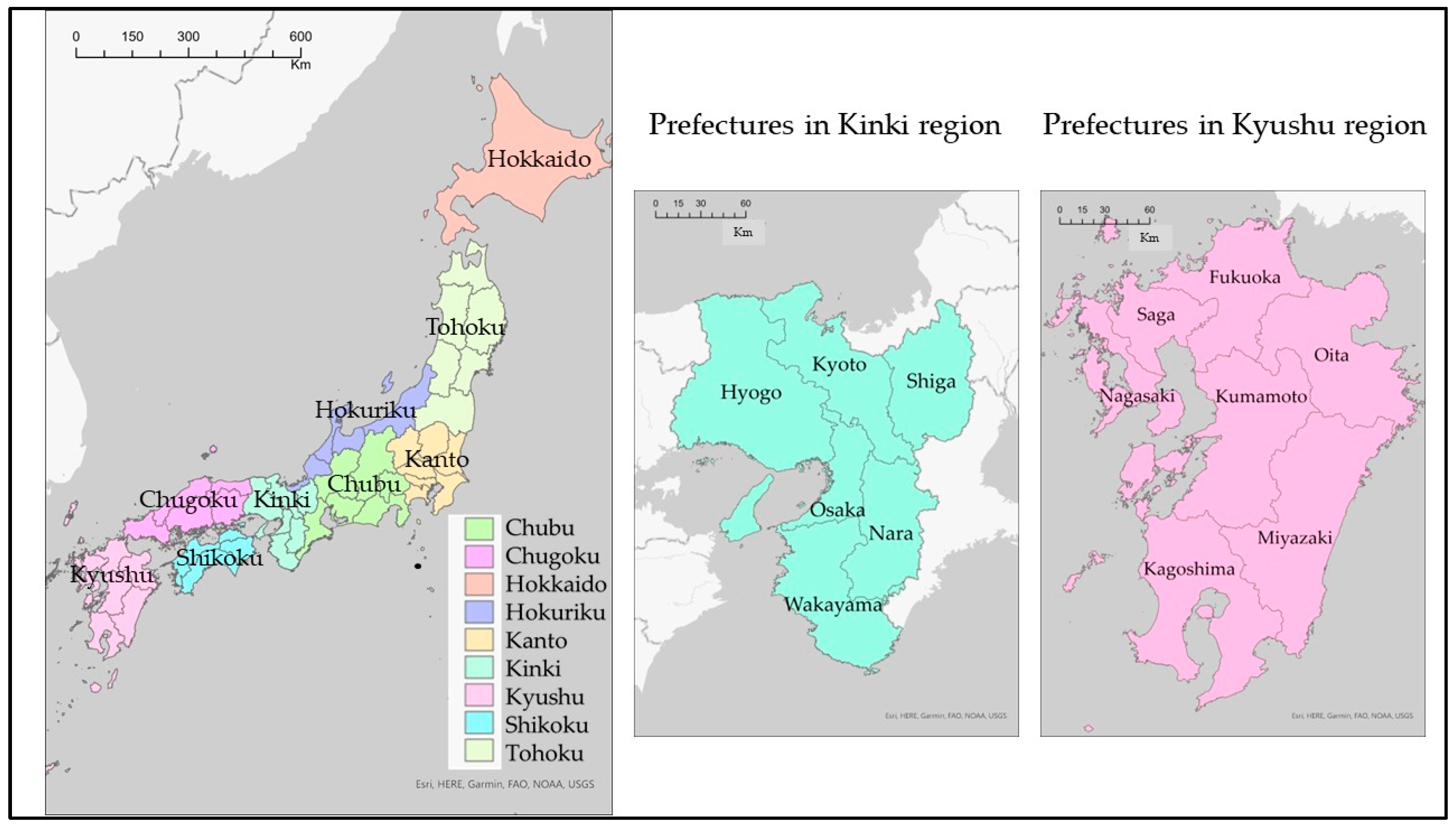
| Number of Municipalities | Max (ha) | Minimum (ha) | Mean (ha) | Median (ha) | |
|---|---|---|---|---|---|
| Hokkaido | 276 | 147,180 | 525 | 28,355 | 20,819 |
| Kinki | 1220 | 67,359 | 15 | 2107 | 1317 |
| Kyushu | 1306 | 53,700 | 47 | 3175 | 1916 |
| Grassland (ha) | Used Grassland (ha) | The Percentage of Grassland (%) | The Proportion of Grassland in Use (%) | |
|---|---|---|---|---|
| Hokkaido | 756,773 | 196,165 | 12.9 | 25.9 |
| Kinki | 59,132 | 31,639 | 2.6 | 53.5 |
| Kyushu | 208,913 | 141,068 | 7.8 | 67.5 |
| Region | Key Points |
|---|---|
| Hokkaido | 80% of municipalities are area with over 50% natural forest clearings. 18 municipalities are area with over 50% non-forest land afforestation. |
| Kyushu | 20% of municipalities are mixed types. vegetation history is diverse. |
| Kinki | Only 5 municipalities in the region are non-forest land afforestation. |
Disclaimer/Publisher’s Note: The statements, opinions and data contained in all publications are solely those of the individual author(s) and contributor(s) and not of MDPI and/or the editor(s). MDPI and/or the editor(s) disclaim responsibility for any injury to people or property resulting from any ideas, methods, instructions or products referred to in the content. |
© 2023 by the authors. Licensee MDPI, Basel, Switzerland. This article is an open access article distributed under the terms and conditions of the Creative Commons Attribution (CC BY) license (https://creativecommons.org/licenses/by/4.0/).
Share and Cite
Ueno, R.; Iwano, J.; Fujiwara, T.; Sato, N. Vegetation History Characteristics of Planted Forests in Japan: Analysis of the 1960 World Census of Agriculture and Forestry. Forests 2024, 15, 59. https://doi.org/10.3390/f15010059
Ueno R, Iwano J, Fujiwara T, Sato N. Vegetation History Characteristics of Planted Forests in Japan: Analysis of the 1960 World Census of Agriculture and Forestry. Forests. 2024; 15(1):59. https://doi.org/10.3390/f15010059
Chicago/Turabian StyleUeno, Ryudai, Junna Iwano, Takahiro Fujiwara, and Noriko Sato. 2024. "Vegetation History Characteristics of Planted Forests in Japan: Analysis of the 1960 World Census of Agriculture and Forestry" Forests 15, no. 1: 59. https://doi.org/10.3390/f15010059
APA StyleUeno, R., Iwano, J., Fujiwara, T., & Sato, N. (2024). Vegetation History Characteristics of Planted Forests in Japan: Analysis of the 1960 World Census of Agriculture and Forestry. Forests, 15(1), 59. https://doi.org/10.3390/f15010059






